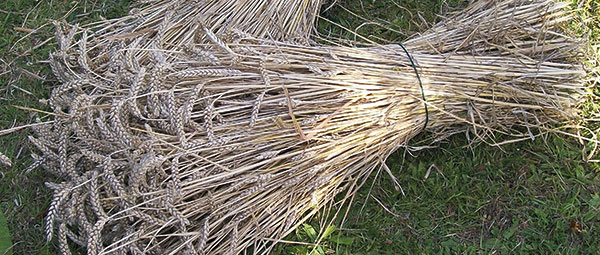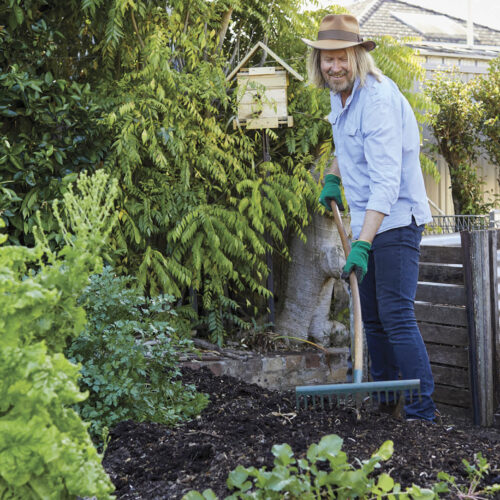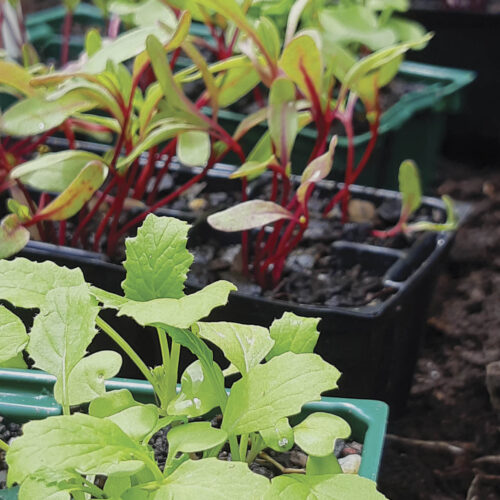Chaffed to Bits
2013-01-26T07:36:26+11:00
It is possible to grow a backyard wheat crop. In these two articles from previous issues of OG Nick Romanowski discusses elements you need to think about when looking at what you can do in your own space.
In the September/October 2011 issue of Organic Gardener magazine, Nick looked at the diversity of grain crops that gardeners could grow and “reconnect” with on their own small plot.
Grow Your Own Grains
Grains are a vital crop that have shaped civilisation, but their diversity is fading. Home gardeners can reconnect with the beauty and usefulness of grain by growing their own.
All true grains come from grasses, by far the most important botanical family of food plants for humans worldwide. Wherever we live, about 60 per cent of our staple diet comes directly from grass seeds in the form of bread, rice, pasta and noodles. Even beer, the world’s most popular alcoholic drink, is made from grain, as are the many types of whisky.
The grass family is also the primary food of most meat animals, from sheep and cattle to guinea pigs and rabbits. Civilisation began with the harvest and storage of grains, and archaeologists have demonstrated that a family could harvest its year’s needs from a stand of wild wheat in just three weeks, using stone ?sickles alone.
Storing the harvest was a different matter. Nomads could not carry such heavy loads as they travelled, so the first villages (and ultimately cities) began as places where people could live year-round, guarding their grain.
Today’s politicians seem to have lost track of the fact that grain continues to be the sustaining core of all societies worldwide, and of civilisation itself. While they are preoccupied with day-to-day economic issues, world grain reserves continue to dwindle, and the diverse landraces (local varieties) of grains developed by many cultures over 10,000 years are disappearing.
Vanishing varieties
As with many other heirloom food plants, the diversity of grains has been shrinking for decades, with more productive modern varieties displacing older landraces. Ironically, what is left of this genetic wealth is now mostly conserved in the seed banks of the multinationals that introduced the newer varieties, and is kept for their own breeding purposes. It has become inaccessible to the people whose ancestors developed these plants in the first place.
While heirloom vegetables have enjoyed a revival in recent decades, Western gardeners appear to have abandoned grains to agribusiness, despite the fact that these seed-producing plants have some significant advantages over vegetables and have carried the human species through eras of climate change ?and uncertainty.
Although there are native species such as Kangaroo grass (Themeda triandra) and Weeping grass (Microlaena stipoides) with potential as perennial grain crops, none of the commercial grains evolved in Australia. However, what diversity there is in these major crops is in need of urgent conservation.
Most grains (including the various millets and all pseudo-cereals) are gluten-free, with the exception of wheat. Barley, oats, rye and triticale have only relatively small quantities of gluten.
Sacred grain
Even today, many societies still treat grains with great reverence, and seeing them growing for the first time can have a powerful, visceral effect on some people. At a recent grain workshop I ran, a Chinese lady approached rice plants on her hands and knees to touch them; although she had been eating rice all her life, she had never before seen the seed ripening on the plant.
Other participants were amazed to discover that the ornamental gardens they were wandering through included diverse millets and amaranths, food plants that were both striking in appearance ?and productive.
Your own plot
One of the reasons gardeners don’t grow their own grain is because it is considered a large-scale operation that requires harvesting machinery to make it worthwhile. Harvesting by hand with scythes and sickles and then processing the grain is time-consuming, but there are many pleasures to be found in this.
Also, there is the myth of poor productivity – so much effort for so little grain. Yet most grains can produce up to six or even eight tonnes per hectare, as long as they have adequate natural rainfall at the right times of their growing cycle. By contrast, a single potato plant may drink hundreds of litres of water over its growing season.
A good rice crop produces 12 tonnes per hectare on irrigated land. These yields are often compared to crops such as tomatoes, which produce about 10 times as much – yet a tomato is 90 per cent water, while grain is measured by its dry weight alone. And if stored properly, the grain will still be living, fresh food in five years or even longer.
If you live in a drought-prone climate and use two kilograms of wheat a week (bread made from freshly made flour is surprisingly filling), you will need up to 150 square metres of ground to produce your own crop for self-sufficiency. That’s just 10 by 15 metres, the equivalent of about five or six suburban nature strips if you’re into guerilla plantings. On the other hand, growing a small crop of rice in an old bathtub is a great experiment, even if it only produces a meal or two.
If you have only a small garden, or none at all, there are many other urban places where grains could be grown, including community and school gardens. Also, schemes ?such as Landshare Australia (www.landshareaustralia.com.au) offer land to growers who have none.
Get growing
Most grains are surprisingly easy to grow on a small scale, don’t suffer from a heavy pest burden and adapt to a wide range of soils. They also need little watering once established – if they are grown in an appropriate climate.
For small-scale plantings you can sow by hand-broadcasting. It does not take much practice to get an even distribution of seed, which can be spread out more uniformly while raking it in to protect the seed from birds. There is no single set sowing rate for grains, as these vary depending on the species, climate ?and variety.
There is also no need to water in. Appropriately selected grains should be planted when they would normally start germinating – that is when they are likely to be watered in by rain. If they are not, it doesn’t really matter because they will just sit there without germinating until the rains do set in.
No great effort is needed to prepare soil. In fact, most grains ?will grow perfectly well in any reasonable suburban garden soil. Grains can also be grown as part of a vegie rotation. For example, a winter wheat crop can be followed with plantings of cabbage, broccoli, cauliflower and kale for the following winter, while earlier-harvested grains such as barley can be followed with many summer vegetables.
The Major Grain Groups
Wheat (spelt and kamut)
Wheat species and forms (Triticum) are complex, long-stabilised hybrids that grow over winter into spring in milder climates, cropping without any need for watering. They vary considerably in appearance and quality of grain (and uses), some with long, slender spokes from the husk surrounding each seed, which is called an awn, while others are virtually awnless. Spelt and kamut, ancient relatives of wheat, are now coming back into favour because of their lower gluten content.
Barley
Barley (Hordeum vulgare) crops in a shorter season than most other grains, and although today it is mostly grown to make beer it remains a subsistence crop in cooler places such as Tibet.
Oats
Oats (Avena sativa) are almost as ?cold tolerant as barley, but must be harvested as soon as possible after ripening as the seed will gradually shake loose if left hanging from the plant.
Rice
Rice (Oryza sativa) is a warm-season crop that is also the single most important food in the world. Not all forms require irrigation; there are some that float in floodwaters three metres deep and only set seed as the waters subside, but some upland varieties are never flooded and only need reliable rain through their growing season.
Maize and Sweetcorn
Unlike most cereals, which are self-pollinating, maize and sweetcorn (Zea mays) are complex plants that must be pollinated by other individuals or their offspring will rapidly lose vigour. These are ?the greediest of the grains, needing generous amounts of nitrogen-rich fertilisers such as manures, as well as generous watering.
Millet
There are many unrelated species of millets, suitable for various climates and soils from arid to seasonally waterlogged (such as Japanese or barnyard millet, Echinochloa frumentacea). However, most millets are extremely drought tolerant once established, including sorghum or great millet (Sorghum bicolor), pearl or African millet (Pennisetum glaucum), French or proso millet (Panicum miliaceum) and teff (Eragrostis teff).
Rye and Triticale
Rye (Secale cereale) is a cooler-climate crop that can be grown in a similar manner to wheat, however it is unreliable in hot summers so triticale (x Triticosecale, a stabilised hybrid with wheat) is becoming more popular with Australian farmers, making a fine-flavoured alternative ?to rolled oats.
Pseudocereals
Buckwheat (Fagopyrum esculentum), amaranth and quinoa are classed as pseudocereals – plants that are not related to grasses but produce grain-?like seeds, many of which are rich in protein compared with true grains.
Buckwheat is usually planted in early spring, but will yield a small crop even if planting has been left till late, and makes a handsome ornamental with its heart-shaped leaves and masses of white flowers.
Amaranths (Amaranthus species and hybrids) are even more striking than buckwheat with their immense flower heads ranging from cream or green to vivid reds, purples and oranges, depending on variety.
Quinoa (Chenopodium quinoa, pronounced ‘keen-wah’) is the most difficult pseudocereal to grow as each variety only produces seed at the particular latitude in which it evolved, and will not usually crop much further north or south. Despite this, it is an increasingly popular gluten-free food.
Resources
Suppliers
Small-scale seed supply options include:
Local organic farmers and stock agents will often provide seed and advice. For older and more obscure varieties, try joining a local seed network (www.seedsavers.net).
Buy bags of whole grain from health food stores.
Books
While many useful books are out of print, you might be able to get copies of these books online:
- Small-Scale Grain Raising, by Gene Lodgson. This was first published by Rodale Press in 1977 and is now available from Chelsea Green Publishing: chelseagreen.com
- Homegrown Whole Grains, by Sara Pitzer. Published in 2009, the measurements listed are imperial and the resources are American, but the information is still applicable. See greenharvest.com.au/books
- Plant Resources of South-East Asia 10: Cereals, edited by GJH Grubben and S Partohardjono. Published by Backuys Publishers in 1996, this technical manual is informative on the diversity, naming and growing of grains.
In the November/December 2011 issue, Nick covered the basics of harvesting and processing these grains.
True Grist
There are grains suitable for virtually every Australian climate, and many species that crop with little attention and no watering were looked at last issue. Growing grain should be easy work for anyone who already has some experience with vegetables or small-scale farming, but the real work begins with the harvest and threshing process. The basic steps to get your grain include: harvesting the crop; threshing – which releases the grain from the stalk; de-hulling (some grains have a hard case or husk around the seed); and winnowing, which separates the grain from the inedible chaff around it.
For harvesting, most backyard grain crops can be reaped in just an hour or two using the right tool – typically a long-wearing blade such as a sickle. To harvest cereal grasses such as wheat, barley and rice, cut the straw near ground level. Using a sickle is easy: bunch a handful of stems close together near the ground in the gloved hand, and slice through the stalks below with the blade. The longer the stalks are, the easier it will be to thresh the grain loose later, but make sure the harvested heads are laid on a dry surface, or tie them into bunches (stooks) and stand these more or less upright.
Lightweight, well-balanced, yet inexpensive steel sickles do a fine job – the best having a serrated blade, which never needs sharpening so they may last a lifetime. However, they can also cause a nasty cut if you become careless through tiredness, so wear a leather glove to protect the hand that bunches the stalks of grain together.
For larger areas, scythes do a faster job as they slice a wider swathe rather than just a fistful of stems at a time, but it takes practise to become proficient with a scythe and the smooth blades must be sharpened regularly while in use. Scythes are available in Australia and there are some groups that offer workshops in how to use them (see ‘Find out More’, below).
Easiest of all to harvest is the seed of pseudocereals such as buckwheat and amaranths, as these ripen over a few weeks so you can simply shake or brush their ripe seed into a large bowl every few days, until they have finished cropping.
Threshing and de-hulling
Threshing is traditionally just a matter of beating the grain heads against a screen or a hard, flat surface where the grain can’t scatter too far. Taking it a step further, if you put in an internet search for ‘small-scale grain threshing machines’ you will find quite an array of wonderful home-made threshers.
Most types of grains have a protective hull or husk around the seed, which also needs to be loosened or removed by pounding after the grain has been threshed; this process may (confusingly) be referred to as both hulling and de-hulling, among other terms. Some grains such as rice and Chinese pearl barley can easily be de-hulled by dropping a vertical bamboo cane onto them, as this is light enough ?that it won’t damage the brittle seed on impact, or with a little experimentation you can do the same job with a mortar and pestle.
At the other extreme, spelt wheat is notoriously hard to de-hull, and you may need to run the grain through a mill, setting the gap between the grinding plates wide enough to fracture the husk while still leaving the seed intact. Whatever the process involved, the de-hulled grains will include chaff and other leftovers, which are removed by winnowing. On a breezy day you can do this by just tossing the mix into the air, allowing the chaff to blow away while the heavier grains fall back to earth – on a tarp or similar.
Winnowing with a finely woven basket also allows any small grit particles to fall through the gaps, leaving only the cleaned grain behind, and once this is completely dry it should be ready to store for many years. In some cases, a strong fan can be used to blow away the chaff.
Enjoying the grain harvest
All grains can be used as soon as they have been cleaned, but if you plan to store them for any length of time they should be dried thoroughly, and this is also essential for preserving seed of the many endangered grains. Stick to moderate temperatures for drying (a sunny room away from direct sunlight is fine), and you can even freeze thoroughly dried grain so it will last many years longer.
With the right equipment, processing and cooking your own grains on a small scale can be ?done one meal at a time to give the freshest taste and greatest nutritional value, although it may sometimes be more convenient to process enough for several days. For example, soaked oats can be steamed and then crushed with an ordinary rolling pin to make rolled oats. These can be cooked immediately or will keep in the fridge for several days. Commercial rolled oats are dried so they will last for years on the supermarket shelf.
Home-grown rice can be cooked just as you have always used it, and many other grains can be sprouted to convert their starch into more readily digestible sugar-like compounds.
Even wholegrain flour is easy to mill at home, and tastes markedly better than the shop-bought product because the natural oils in the seed gradually become rancid once it has been ground. There are many types of small flour mills available, from hand-operated types to streamlined electric mills that wouldn’t look out of place in a restaurant kitchen. Stone mills are highly regarded because they work slowly, whereas the faster-acting hammer mills can overheat the flour, reducing nutrient value. Some smaller stone mills include interchangeable steel plates that can also be used to de-hull grain or to grind oily seeds that would permanently clog stone plates.
Fresh is best
Even if you have neither the space nor the time to grow your own, organic and biodynamic grains are widely available and it is worth taking the time to use these to make your own fresh breads and noodles. Part of the pleasure of the process is feeling in touch with the thousands of generations of humans who first harvested and then domesticated the wild grains. You don’t even need to value human history to appreciate freshly ground grains because once you have tasted the slightly nutty, fragrant taste of bread or pasta made from freshly ground grains it is hard to go back to eating the stale products of the industrial age.






